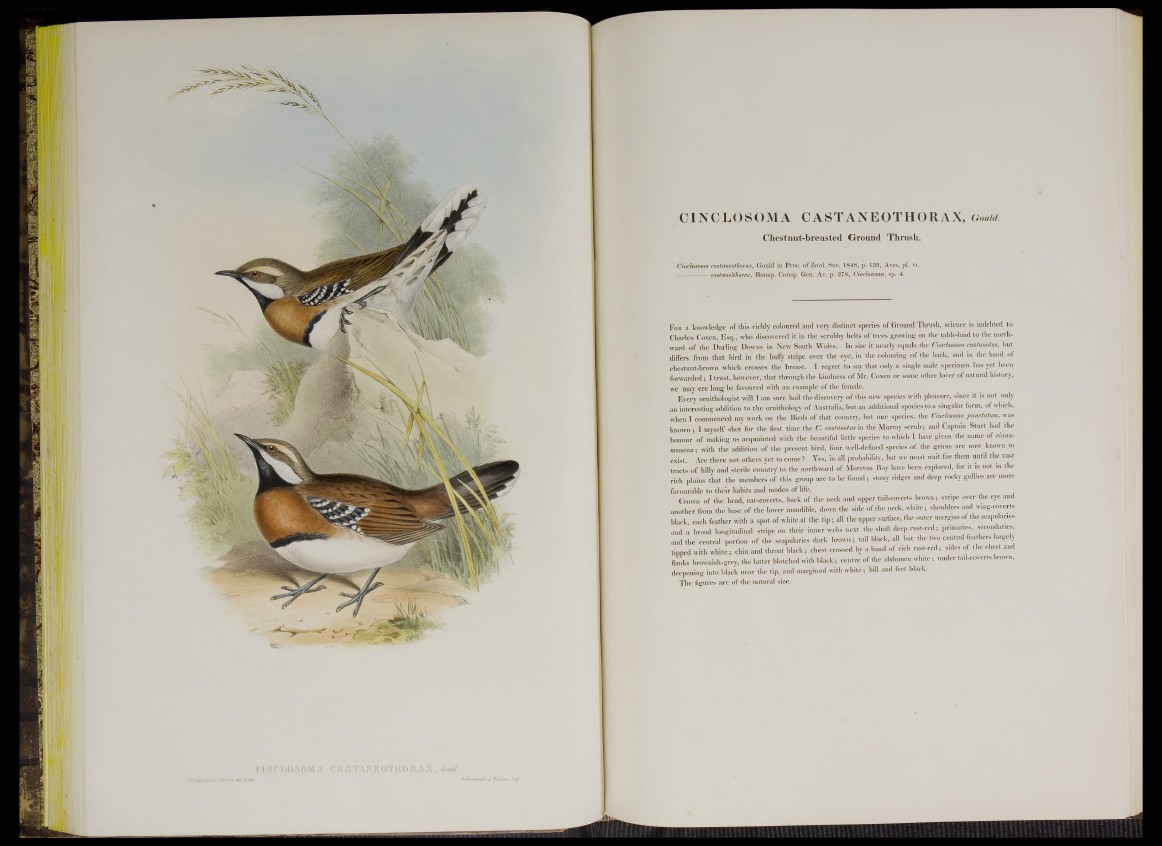
'JLKC 1,0 SOM A CAS TAKE QTHORAX, fo iM .
CINCLOSOMA C ASTANEOTHORAX, Gould.
Chestnut-breasted Ground Thrush.
Cinclosoma castaneotliorax, Gould in Proc. of Zool. Soc. 1848, p. 139, Aves, pi. vi.
------------- castaneithorax, Bonap. Consp. Gen. Av. p. 278, Cinclosoma, sp. 4.
F ob a knowledge of this richly coloured and very distinct species of Ground Thrush, science is indebted to
Charles Coxen, Esq., who discovered it in the scrubby belts of trees growing on the table-land to the northward
of the Darling Downs in New South Wales. In size it nearly equals the Cinclosoma castanotus, but
differs from that bird in the huffy stripe over the eye, in the colouring of the back, and in the band of
chestnut-brown which crosses the breast. I regret to say that only a single male specimen has yet been
forwarded; I trust, however, that through the kindness of Mr. Coxen or some other lover of natural history,
we may ere long be favoured with an example of the female.
Every ornithologist will I am sure hail the discovery of this new species with pleasure, since it is not only
an interesting addition to the ornithology of Australia, but an additional species to a singular form, of which,
when I commenced my work on the Birds of that country, hut one species, the Cinclosoma punctatum, was
known; I myself shot for the first time the C. castanotus in the Murray scrub; and Captain Sturt had the
honour of making us acquainted with the beautiful little species to which I have given the name of cinna-
momeus; with the addition of the present bird, four well-defined species of the genus are now known to
exist. Are there not others yet to come ? Yes, in all probability, but we must wait for them until the vast
tracts of hilly and sterile country to the northward of Moreton Bay have been explored, for it is not m the
rich plains that the members of this group are to be found ; stony ridges and deep rocky gullies are more
favourable to their habits and modes of life.
Crown of the head, ear-coverts, back of the neck and upper tail-coverts brown; stripe over the eye and
another from the base of the lower mandible, down the side of the neck, white; shoulders and wing-coverts
black each feather with a spot of white at the tip ; all the upper surface, the outer margins of the scapulanes
and a broad longitudinal stripe on their inner webs next the shaft deep rust-red; primaries, secondaries,
and the central portion of the scapularies dark brown; tail black, all but the two central feathers largely
tipped with white; chin and throat black; chest crossed by a band of rich rust-red; sides of the chest and
flanks brownish-grey, the latter blotched with black; centre of the abdomen white ; under ta.l-coverts brown,
deepening into black near the tip, and margined with white; bill and feet black.
The figures are of the natural size.